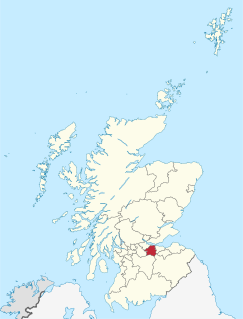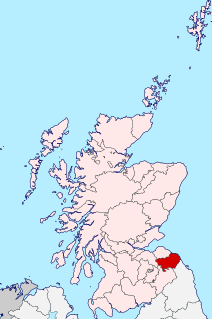A shire is a traditional term for a division of land, found in Great Britain, Australia and some other English-speaking countries. It was first used in Wessex from the beginning of Anglo-Saxon settlement, and spread to most of the rest of England in the tenth century. In some rural parts of Australia, a shire is a local government area; however, in Australia it is not synonymous with a "county", which is a lands administrative division.

Midlothian is one of the 32 council areas of Scotland, UK. It borders Edinburgh, East Lothian and the Scottish Borders council areas.

West Lothian is one of the 32 council areas of Scotland, and one of its historic counties. The county, which was also known as Linlithgowshire, was bounded by the Avon to the west and the Almond to the east. The modern council area occupies a smaller area, with areas in the west transferred to Falkirk and areas in the east transferred to Edinburgh following local government reforms in the late 20th century. It did however gain areas from Midlothian.
Local government in Scotland is organised through 32 unitary authorities designated as councils which consist of councillors elected every five years by registered voters in each of the council areas.

The counties or shires of Scotland are geographic subdivisions of Scotland established in the Middle Ages. Originally established for judicial purposes, from the 17th century they started to be used for local administration purposes as well. The areas used for judicial functions (sheriffdoms) came to diverge from the shires, which ceased to be used for local government purposes after 1975 under the Local Government (Scotland) Act 1973.

For local government purposes, Scotland is divided into 32 areas designated as "council areas", which are all governed by single-tier authorities designated as "councils". They have the option under the Local Government (Scotland) Act 1997 of being known as a "comhairle" when opting for a Gaelic name; only Comhairle nan Eilean Siar has chosen this option, whereas the Highland Council has adopted its Gaelic form alongside its English equivalent informally.

Berwickshire is a historic county, registration county and lieutenancy area in the Scottish Borders. It takes its name from Berwick-upon-Tweed, which was part of Scotland at the time of the county's formation, but became part of England in 1482.

Kincardineshire, also known as the Mearns, is a historic county, registration county and lieutenancy area on the coast of northeast Scotland. It is bounded by Aberdeenshire on the north and west, and by Angus on the south.

Stirlingshire or the County of Stirling is a historic county and registration county of Scotland. Its county town is Stirling.
A police burgh was a Scottish burgh which had adopted a “police system” for governing the town. They existed from 1833 to 1975.

Renfrewshire or the County of Renfrew is a historic county, registration county and lieutenancy area in the west central Lowlands of Scotland.
The History of local government in Scotland is a complex tale of largely ancient and long established Scottish political units being replaced after the mid 20th century by a frequently changing series of different local government arrangements.
Scottish Westminster constituencies were Scottish constituencies of the House of Commons of the Parliament of Great Britain, normally at the Palace of Westminster, from 1708 to 1801, and have been constituencies of the House of Commons of the Parliament of the United Kingdom, also at Westminster, since 1801. Constituency boundaries have changed on various occasions, and are now subject to both periodical and ad hoc reviews of the Boundary Commission for Scotland.
Sir John Baird of Newbyth, Lord Newbyth (1620–1698), was a Scottish advocate, judge, politician and diplomat. He served as Commissioner for Aberdeenshire in the Parliament of Scotland.
Archibald Douglas 13th of Cavers was a Scottish politician. In 1701, prior to the Union of Scotland and England, Douglas had been able to return himself as one of Roxburghshire's four Commissioners to the Scottish Parliament. In his electoral capacity, he consistently opposed the Roxburghe interest both in the Scottish and British Parliaments. Repeated successes prompted his son William to remark with pardonable exaggeration in 1712 that "you have it in your hands to make the Member for the county."
A sheriffdom is a judicial district of Scotland. Originally identical to the Shires of Scotland, from the eighteenth century many counties were grouped to form "sheriffdoms".

Cockpen is a parish in Midlothian, Scotland, containing at its north-west corner the town of Bonnyrigg, which lies two miles (3.2 km) south-west of Dalkeith. It is bounded on the west and north by the parish of Lasswade, on the east, by Newbattle and on the south by Carrington. It extends about three miles (4.8 km) from north to south and its greatest breadth is about 2 1⁄2 miles.
The Sheriff of Edinburgh was historically the royal official responsible for enforcing law and order and bringing criminals to justice in Edinburgh, Scotland. Prior to 1748 most sheriffdoms were held on a hereditary basis. From that date, following the Jacobite uprising of 1745, they were replaced by salaried sheriff-deputes, qualified advocates who were members of the Scottish Bar.














